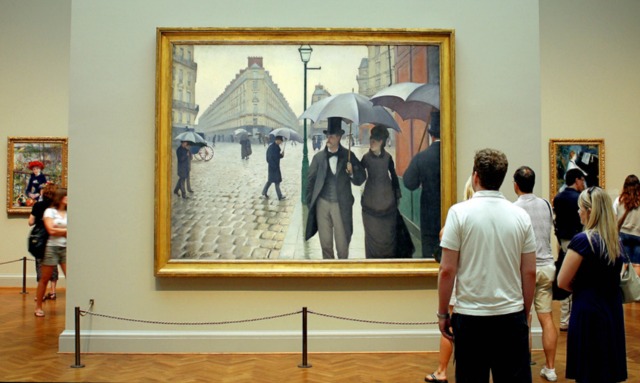Caillebotte Uncovered: Art Institute Restoration Reveals Hidden Details
By Jessica Mlinaric in Arts & Entertainment on Jun 22, 2014 8:00PM
The art world is replete with mysteries, many hidden in plain sight.
In what was supposed to be a routine cleaning, the Art Institute of Chicago’s recent restoration of Gustave Caillebotte’s Paris Street; Rainy Day uncovered details about the artist’s original intention that have been buried under varnish for decades.
Conservator Faye Wrubel and assistant paintings conservator Kelly Keegan recently discussed these findings in a lecture at the Art Institute, proving that even in the case of beloved masterpiece, there’s more than meets the eye.
Completed in 1877, the painting spent at least 50 years stored in a French chateau before eventually being purchased by the Art Institute in 1964.
While there is no record of a previous restoration, Wrubel estimates a treatment occurred a half-century ago before the work was sold. Using ultraviolet, x-ray, microscopy, and infrared imaging in their analysis, the conservation team discovered dark blotches in the sky indicating a layer of paint had been added.
Wrubel painstakingly began removing the varnish from the massive 6-by-9 foot canvas using cotton swabs.
She even turned the work upside down to reach the top of the painting for cleaning. The old varnish had blanched the painting’s surface, giving it a milky appearance.
The striking results of the restoration reveals greater saturation of color, sharper edges, and more contrast with an overall effect of more visual depth. Overpainting was removed from the once yellow sky, exposing a bluer surface with gradation indicating light and movement.
“What we have been seeing all these years may have been beautiful, we may have all loved it, but it wasn’t right,” Wrubel said of the findings’ impact.
In addition to visible details that were brought to light, conservators uncovered new information about the masterpiece by comparing the ultraviolet and x-ray images to a preparatory sketch for the painting as well as study residing at Paris’ Musée Marmottan Monet.
Paris Street; Rainy Day is one of the Art Institute’s most popular works. The next time you pay a visit to Gallery 201, consider these details.
The edge was not the edge! Conservators stripped away about two inches of added paint at the left side of the canvas, revealing the original raw edge the artist had intended. One can see rest of the carriage vanishes into thin air, as nothing to the left of it was meant to be shown. The Art Institute is considering reframing the work to its intended dimensions.
The man at the right foreground was added by Caillebotte. Originally, the red building was much closer to the female figure as indicated by faint specks of the red paint visible above the drainpipe. The figure contributes to the feeling of movement and spontaneity of the work, as does the subtle curve of the street now visible behind the central male figure.
The female figure was long thought to be wearing a pearl earring, but its sparkling appearance after cleaning reveals it’s actually a diamond. The luminescent peach glow around her shoulders had previously been hidden under varnish. It’s also thought that her gloved hand was originally bare, as seen in the Marmottan painting.
After the cleaning, 19th-century European painting and sculpture curator Gloria Groom noticed that two figures assumed to be walking together were actually passing each other. Now that the face and hands of the figures are visible it’s clear the woman is passing the man in the street.
One of the figures seen behind the central male figure is an inversion of a famous sketch by Caillebotte.
Not everything has changed. The central building in the painting houses a pharmacy at street level. In a recent visit, Wrubel sought out the famous Paris street and discovered that it's still a pharmacy.
Layered brushstrokes indicate wet paint modeling on the canvas rather than the palette. Caillebotte’s emphasis capturing motion and varied light revealed in this restoration may cause the art world to reconsider his standing as a realist and place him amongst his Impressionist friends.
“I spent so much time with this picture I felt I became part of it,” said Wrubel on the treatment process.
The world has spent over a century with this well known masterpiece, and it’s thrilling to find that, after such time, it still has hidden narratives to share.
Here's video:
